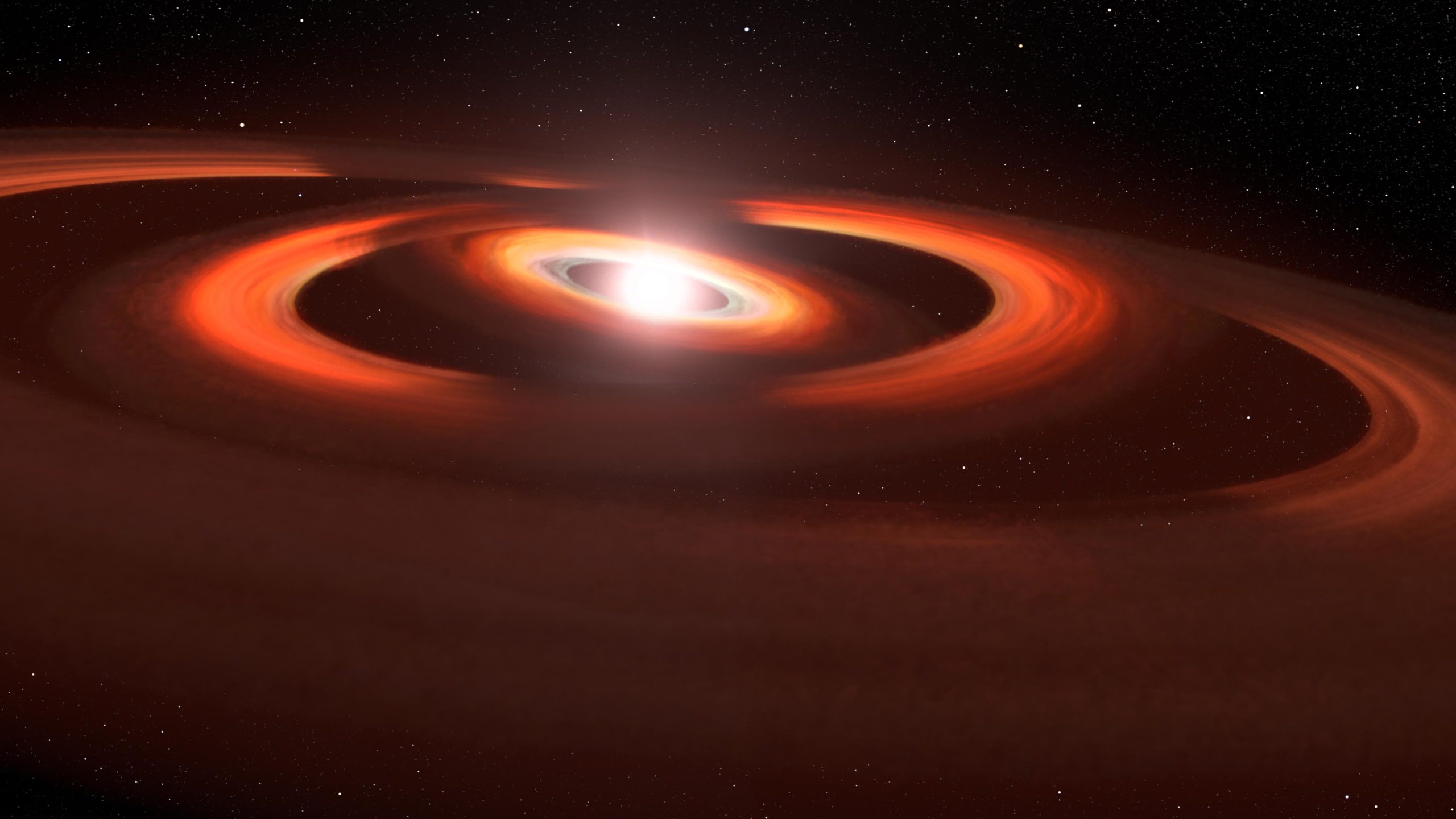Koncept tohoto umělce je založen na snímcích Hubble Space Telescope disků plynu a prachu kolem mladé hvězdy TW Hydrae. Snímky z Hubbleova vesmírného dalekohledu ukazují stíny pohlcující disky, které obklopují systém. Vysvětlením je, že tyto stíny pocházejí z mírně nakloněných vnitřních disků, které brání světlu hvězd dostat se k vnějšímu disku a vrhají tak stín. Disky jsou mírně nakloněny k sobě kvůli gravitační síle neviditelných planet, která deformuje strukturu disku. Poděkování: NASA, Aura/STScI, Evropská vesmírná agentura, Leah Hostack (STScI)
Neviditelné novorozené planety rozvíří prach kolem mladé hvězdy
Náš svět je tak vrtkavý, že si občas rád hraje na schovávanou. V roce 2017 byli astronomové překvapeni, když viděli obrovský stín pohlcující disk prachu a plynu obklopující blízkou mladou hvězdu TW Hydrae. Stín vrhá vnitřní disk prachu a plynu, který je mírně nakloněn k rovině vnějšího disku. Stín lze jasně vidět pouze proto, že systém je na Zemi nakloněn tváří v tvář, což astronomům umožňuje pohled na disk z ptačí perspektivy, zatímco stín se míhá kolem disku jako ručička pohybující se na hodinách.
Ale hodinky mají dvě ručičky (na hodiny a minuty), které se pohybují různou rychlostí. A ukázalo se, že TW Hydrae je také. Astronomové použili HST k nalezení druhého stínu vycházejícího z dalšího vnitřního disku, nakloněného směrem ke dvěma vnějším diskům. Proto se systém jeví jako stále složitější s alespoň třemi překrývajícími se kotouči mírně vůči sobě nakloněnými. Disky jsou proxy pro neviditelné planety kolem hvězdy. Každá planeta svou gravitační silou přitahuje materiál blízko hvězdy a deformuje to, co by bylo dokonale plochým diskem ve tvaru palačinky, kdyby tam planety nebyly. To není překvapivé, protože planety v naší sluneční soustavě mají oběžné roviny, které se od sebe liší sklonem o několik stupňů. TW Hydrae poskytuje astronomům místo u prstenu, aby viděli, jak naše sluneční soustava mohla vypadat během let svého vzniku.

Porovnání snímků z Hubbleova vesmírného dalekohledu, které jsou od sebe vzdáleny několik let, odhalilo dva děsivé stíny pohybující se proti směru hodinových ručiček přes disk plynu a prachu obklopující mladou hvězdu TW Hydrae. Disky se na Zemi naklánějí tváří v tvář, čímž astronomům poskytují pohled na dění kolem hvězdy z ptačí perspektivy. Levá fotografie pořízená v roce 2016 ukazuje pouze jeden stín [A] Je 11:00. Tento stín vrhá vnitřní disk, který je mírně nakloněn k vnějšímu disku a blokuje světlo hvězd. Obrázek vlevo ukazuje druhý stín, který se objevil z jiného disku [C] 7:00 hod., jak je natočeno v roce 2021. Původní vnitřní disk značen [B] v tomto následujícím představení. Stíny rotují kolem hvězdy různými rychlostmi jako ve směru hodinových ručiček. Jsou důkazem dvou neviditelných planet, které na své oběžné dráhy vtáhly prach. Díky tomu se o sebe mírně nakloní. Toto je snímek ve viditelném světle pořízený zobrazovacím spektroradiometrem kosmického dalekohledu. Pro vylepšení detailů byla přidána syntetická barva. Poděkování: NASA, ESA, STScI, John Debes (AURA/STScI pro ESA), Joseph DePasquale (STScI)
Hubbleův vesmírný dalekohled sleduje stínovou hru kolem disku tvořícího planetu
Mladá hvězda TW Hydrae hraje „stínové loutky“ s vědci, kteří ho sledují[{“ attribute=““>NASA’s Hubble Space Telescope.
In 2017, astronomers reported discovering a shadow sweeping across the face of a vast pancake-shaped gas-and-dust disk surrounding the red dwarf star. The shadow isn’t from a planet, but from an inner disk slightly inclined relative to the much larger outer disk – causing it to cast a shadow. One explanation is that an unseen planet’s gravity is pulling dust and gas into the planet’s inclined orbit.
Now, a second shadow – playing a game of peek-a-boo – has emerged in just a few years between observations stored in Hubble’s MAST archive. This could be from yet another disk nestled inside the system. The two disks are likely evidence of a pair of planets under construction.
TW Hydrae is less than 10 million years old and resides about 200 light-years away. In its infancy, our solar system may have resembled the TW Hydrae system, some 4.6 billion years ago. Because the TW Hydrae system is tilted nearly face-on to our view from Earth, it is an optimum target for getting a bull’s-eye-view of a planetary construction yard.
The second shadow was discovered in observations obtained on June 6, 2021, as part of a multi-year program designed to track the shadows in circumstellar disks. John Debes of AURA/STScI for the European Space Agency at the Space Telescope Science Institute in Baltimore, Maryland, compared the TW Hydrae disk to Hubble observations made several years ago.
“We found out that the shadow had done something completely different,” said Debes, who is principal investigator and lead author of the study published in The Astrophysical Journal. “When I first looked at the data, I thought something had gone wrong with the observation because it wasn’t what I was expecting. I was flummoxed at first, and all my collaborators were like: what is going on? We really had to scratch our heads and it took us a while to actually figure out an explanation.”
The best solution the team came up with is that there are two misaligned disks casting shadows. They were so close to each other in the earlier observation they were missed. Over time they’ve now separated and split into two shadows. “We’ve never really seen this before on a protoplanetary disk. It makes the system much more complex than we originally thought,” he said.
The simplest explanation is that the misaligned disks are likely caused by the gravitational pull of two planets in slightly different orbital planes. Hubble is piecing together a holistic view of the architecture of the system.
The disks may be proxies for planets that are lapping each other as they whirl around the star. It’s sort of like spinning two vinyl phonograph records at slightly different speeds. Sometimes labels will match up but then one gets ahead of the other.
“It does suggest that the two planets have to be fairly close to each other. If one was moving much faster than the other, this would have been noticed in earlier observations. It’s like two race cars that are close to each other, but one slowly overtakes and laps the other,” said Debes.
The suspected planets are located in a region roughly the distance of Jupiter from our Sun. And, the shadows complete one rotation around the star about every 15 years – the orbital period that would be expected at that distance from the star.
Also, these two inner disks are inclined about five to seven degrees relative to the plane of the outer disk. This is comparable to the range of orbital inclinations inside our solar system. “This is right in line with typical solar system style architecture,” said Debes.
The outer disk that the shadows are falling on may extend as far as several times the radius of our solar system’s Kuiper belt. This larger disk has a curious gap at twice Pluto’s average distance from the Sun. This might be evidence for a third planet in the system.
Any inner planets would be difficult to detect because their light would be lost in the glare of the star. Also, dust in the system would dim their reflected light. ESA’s Gaia space observatory may be able to measure a wobble in the star if Jupiter-mass planets are tugging on it, but this would take years given the long orbital periods.
The TW Hydrae data are from Hubble’s Space Telescope Imaging Spectrograph. The James Webb Space Telescope’s infrared vision may also be able to show the shadows in more detail.
Reference: “The Surprising Evolution of the Shadow on the TW Hya Disk” by John Debes, Rebecca Nealon, Richard Alexander, Alycia J. Weinberger, Schuyler Grace Wolff, Dean Hines, Joel Kastner, Hannah Jang-Condell, Christophe Pinte, Peter Plavchan and Laurent Pueyo, 4 May 2023, The Astrophysical Journal.
DOI: 10.3847/1538-4357/acbdf1
The Hubble Space Telescope is a project of international cooperation between NASA and ESA. NASA’s Goddard Space Flight Center in Greenbelt, Maryland, manages the telescope. The Space Telescope Science Institute (STScI) in Baltimore conducts Hubble science operations. STScI is operated for NASA by the Association of Universities for Research in Astronomy, in Washington, D.C.

„Unapologetický analytik. Rozzuřeně skromný kávový evangelista. Hráč. Nelze psát s boxerskými rukavicemi. Student. Podnikatel.“
You may also like
-
Roboti vs zvířata: kdo vyhraje závod v přirozeném prostředí?
-
CDC říká, že byly identifikovány první zdokumentované případy HIV přenášených kosmetickými jehlami
-
Bezprecedentní objev meteoritu zpochybňuje astrofyzikální modely
-
Třem ženám byl diagnostikován HIV poté, co dostaly „upírskou léčbu“ v Novém Mexiku | AIDS a HIV
-
Jsou jablka zdravá? Navíc zde jsou ta nejsladší jablka, která si můžete koupit.

